This post is avaliable in both English and Spanish (translation with DeepL). All screenshots were captured by myself.
Este post está disponible en Inglés y Español (translation with DeepL). Todas las fotos capturadas por mí.
English
Taiko no Tatsujin is a fascinating rhythm game in how it is very easy to understand but still can give you a huge challenge from learning it and then playing harder maps. The combination of simple instructions with an endearing presentation have kept Taiko popular across the world even when the series was officially never localized outside of a PS2 and the latest Switch entries.
The series began in arcades in 2000 like almost all rhythm games, which is attributed to the possibility of special control setups; Taiko is no exception to this as you had to hit a huge drum controller with two sticks on the center and the rim of the drums in order to hit the red and blue notes respectively. However, this adapts well to playing with buttons or a keyboard as well (depending of the way you play), but there are peripherals that allow the original intended Drum experience which looks quite fun.
On top of the red and blue notes (labeled "Don" and "Kat"), there are bigger versions of this notes which, while can also be cleared with hitting one side of the center or rim, you have to hit both sides of them to get a "Good" note when hitting those (aside from being accurate). There are also yellow bars which don't contribute to the progress meter but gives you points by mashing the drums as fast as you can, and red balloons which you need to hit Don a certain amount of times to clear.
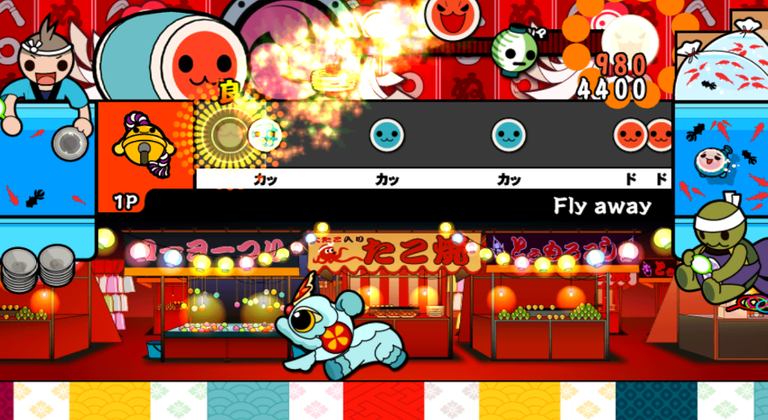
Game: Taiko no Tatsujin Wii 5: Chou Gouka Han
Unlike many other rhythm games, Taiko does not use a lifebar that decreases if you fail notes and ends the game if it depletes. Instead, you get the progress meter that only goes up if you keep hitting notes correctly through the whole song, and there's a yellow area near the end of it. If you finish the song and the meter is on that yellow area (be it barely or at 100%), you have cleared the stage; if it is below that though then you failed it. This can help with practice as you don't get booted if missing too much, but still requires you to be good enough to reach the win condition. Clearing a stage gives you a silver crown, while doing a Full Combo on it (don't miss a single note) rewards you a gold crown.
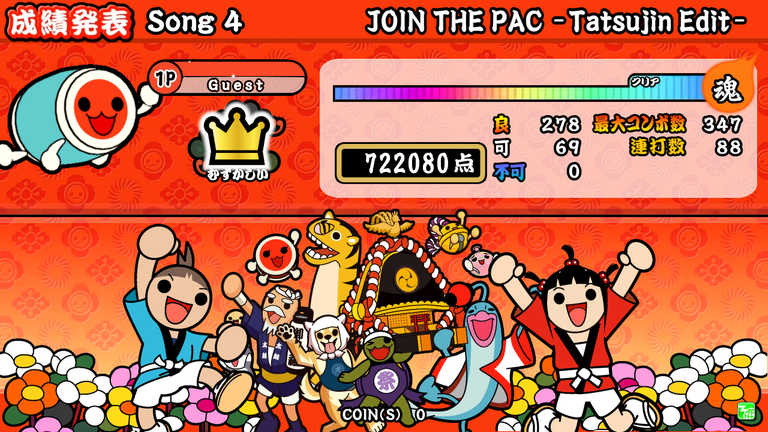
Game: BetterTaikoCatsCaffe (Unofficial simulator)
You might be wondering about if I'm speaking about a specific game...but with the simplicity of the premise, the biggest variation between games on arcades and consoles are the songlists, whatever controller you use, extra features, and sometimes exclusive extra notes/gimmicks. While this can be said about most rhythm games, it really feels like this for Taiko as the presentation doesn't vary too much between games and the gameplay is quite uniform in all versions. The most curious difference is how the same song in different games (arcade versions, home console versions and portable versions) might have altered or different charts, be it because of improvements from newer versions, and increased or decreased difficulty based on whatever platform the game is at.
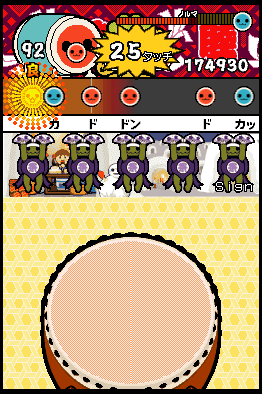
Game: Taiko No Tatsujin DS 3 - Dororon Yokai Daikessen
The Taiko no Tatsujin games can have a broad appeal: The amount of songs and simplicity it can offer for casual and new players on lower difficulties is quite convenient, and for those that are awaiting more challenges after clearing stages on Muzukashii (Hard), many stages in Oni (Very Hard) are incredibly tough with their patterns. Out of the amount of rhythm games out there, Taiko is the most lenient with the learning curve regarding input and instructions (DDR has four notes to hit, GH has 5 and strumming, beatmania IIDX has 7, and osu needs you to use your mouse/pen and keyboard to aim and hit notes), which makes it quite deceptive regarding how complex charts can get on the highest difficulty.
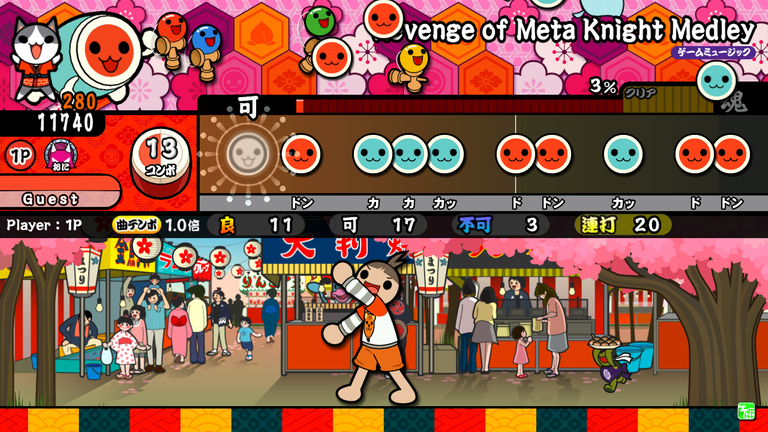
Game: BetterTaikoCatsCaffe (Unofficial simulator)
With the simple gameplay yet huge appeal and fanbase, there are a couple of unofficial simulators similar to what Stepmania/Etterna is to Dance Dance Revolution, and there are people as well that make both custom charts and port official charts from the original games to be played on these simulators. As noted on some of the screenshots, I use BetterTaikoCatsCaffe as my preferred sim. However, osu! also has a Taiko mode which, considering osu's popularity, has got to more players and more custom charts, even though has some few gameplay differences and I feel better playing with BetterTaiko.
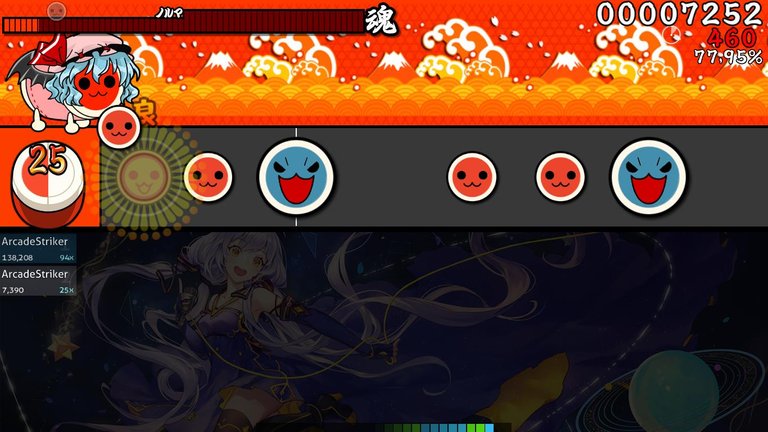
Game: osu! (Using a Taiko skin)
If you are interested in trying out Taiko on PC, you can download osu! (though you have to look up for specific charts that have Taiko support) and/or get started with BetterTaikoCatsCaffe through this guide, which I used as well. I hope that you people enjoy drumming!
Español
Taiko no Tatsujin es un juego de ritmo fascinante por lo fácil que es de entender, pero aún así puede suponer un gran reto al aprenderlo y luego jugar a mapas más difíciles. La combinación de instrucciones sencillas con una presentación entrañable ha mantenido la popularidad de Taiko en todo el mundo, incluso cuando la serie nunca fue oficialmente localizada fuera de una PS2 y las últimas entradas de Switch.
La serie comenzó en los salones recreativos en el año 2000, como casi todos los juegos de ritmo, lo que se atribuye a la posibilidad de configuraciones de control especiales; Taiko no es una excepción a esto, ya que había que golpear un enorme controlador de tambor con dos palos en el centro y el borde de los tambores con el fin de golpear las notas rojas y azules, respectivamente. Sin embargo, esto se adapta bien a jugar con botones o con un teclado también (dependiendo de la forma en que se juegue), pero hay periféricos que permiten la experiencia original del tambor que parece bastante divertida.
Además de las notas rojas y azules (etiquetadas como "Don" y "Kat"), hay versiones más grandes de estas notas que, aunque también se pueden eliminar golpeando un lado del centro o del borde, tienes que golpear ambos lados de ellas para conseguir una nota "Buena" al golpearlas (aparte de ser preciso). También hay barras amarillas que no contribuyen al medidor de progreso, pero que te dan puntos al golpear los tambores tan rápido como puedas, y globos rojos que tienes que golpear a Don una cierta cantidad de veces para eliminarlos.

Juego: Taiko no Tatsujin Wii 5: Chou Gouka Han
A diferencia de muchos otros juegos de ritmo, Taiko no utiliza una barra de vida que disminuye si fallas notas y termina el juego si se agota. En su lugar, tienes un medidor de progreso que solo sube si sigues tocando las notas correctamente durante toda la canción, y hay una zona amarilla cerca del final. Si terminas la canción y el medidor está en esa zona amarilla (ya sea apenas o al 100%), has superado la fase; si está por debajo, entonces la has suspendido. Esto puede ayudar a la práctica, ya que no te expulsan si fallas demasiado, pero aún así tienes que ser lo suficientemente bueno para alcanzar la condición de victoria. Si superas una fase, recibirás una corona de plata, mientras que si haces un combo completo (no te pierdas ni una sola nota) recibirás una corona de oro.

Juego: BetterTaikoCatsCaffe (Simulador no oficial)
Puede que te preguntes si estoy hablando de un juego en concreto... pero con la simplicidad de la premisa, la mayor variación entre los juegos de los salones recreativos y los de las consolas son las listas de canciones, el mando que utilices, las características extra y, a veces, las notas extra/trucos exclusivos. Aunque esto puede decirse de la mayoría de los juegos de ritmo, en el caso de Taiko es así, ya que la presentación no varía demasiado entre juegos y la jugabilidad es bastante uniforme en todas las versiones. La diferencia más curiosa es cómo la misma canción en diferentes juegos (versiones arcade, versiones para consolas domésticas y versiones portátiles) puede tener gráficos alterados o diferentes, ya sea por las mejoras de las nuevas versiones, y por el aumento o disminución de la dificultad según la plataforma en la que se encuentre el juego.

Juego: Taiko No Tatsujin DS 3 - Dororon Yokai Daikessen.
Los juegos de Taiko no Tatsujin pueden tener un amplio atractivo: La cantidad de canciones y la simplicidad que puede ofrecer para los jugadores casuales y nuevos en las dificultades más bajas es bastante conveniente, y para aquellos que están esperando más desafíos después de despejar las etapas en Muzukashii (Difícil), muchas etapas en Oni (Muy Difícil) son increíblemente difíciles con sus patrones. De la cantidad de juegos de ritmo que hay, Taiko es el más indulgente con la curva de aprendizaje en lo que respecta a la entrada y las instrucciones (DDR tiene cuatro notas para golpear, GH tiene 5 y rasgueo, beatmania IIDX tiene 7, y osu necesita que uses el ratón/bolígrafo y el teclado para apuntar y golpear las notas), lo que hace que sea bastante engañoso en cuanto a lo complejo que pueden llegar a ser los gráficos en la dificultad más alta.

Juego: BetterTaikoCatsCaffe (Simulador no oficial)
Debido a la sencillez del juego, pero a su enorme atractivo y a su base de fans, hay un par de simuladores no oficiales similares a lo que Stepmania/Etterna es para Dance Dance Revolution, y también hay gente que hace cartas personalizadas y porta cartas oficiales de los juegos originales para jugar en estos simuladores. Como se indica en algunas de las capturas de pantalla, yo uso BetterTaikoCatsCaffe como mi simulador preferido. Sin embargo, osu! también tiene un modo Taiko que, teniendo en cuenta la popularidad de osu, ha conseguido más jugadores y más cartas personalizadas, aunque tiene algunas pocas diferencias de juego y me siento mejor jugando con BetterTaiko.

Juego: osu! (Usando un skin de Taiko)
¡Si estás interesado en probar el Taiko en el PC, puedes descargarte osu! (aunque hay que buscar las tablas específicas que tienen soporte para Taiko) y/o empezar con BetterTaikoCatsCaffe a través de esta guía, que yo también utilicé. ¡Espero que ustedes disfruten de Taiko!
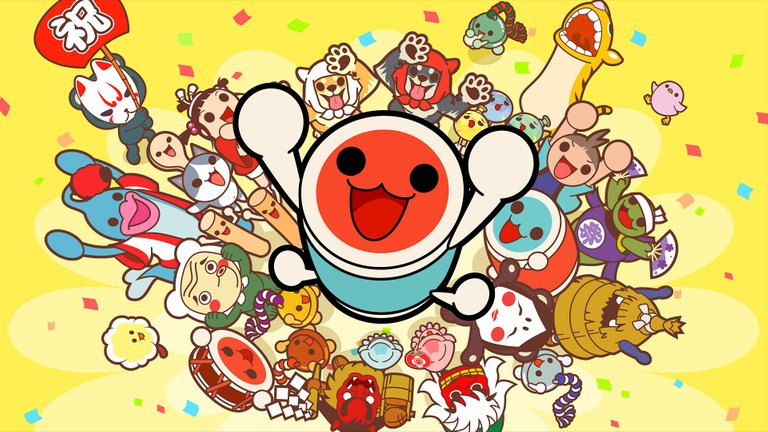
This game is a an absolute blast. The mechanics are simple but the difficulty can get insane. As a percussionist it really hit that sweet spot for me.
Justamente pensé que el post se trataba de Osu, específicamente el modo de juego Taiko ya que lo tiene incorporado. De hecho es bastante bueno y existe mucha disponibilidad en cuanto a mapas para ese modo de juego.